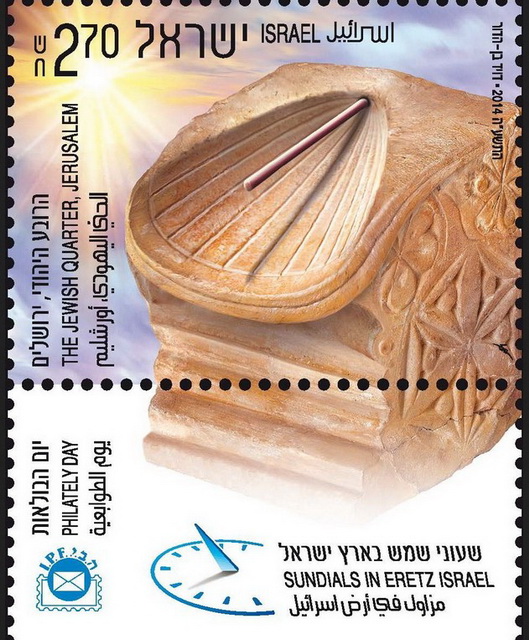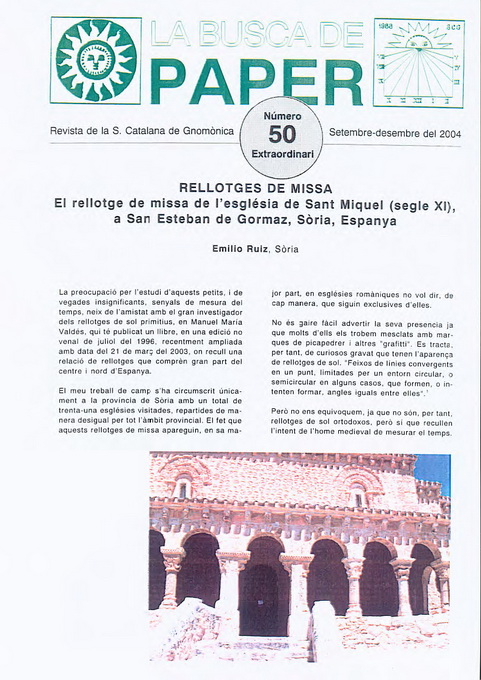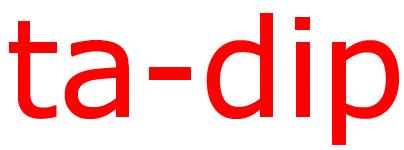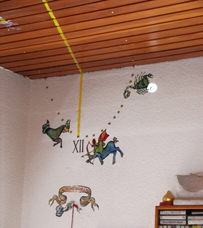I S R A E L
Sonnenuhren in Israel

Urheber TUBS

Quelle: WIKIPEDIA – Israel-Link
Totes Meer. Urheber This file is a work by Ester Inbar
Tempelberg - Jerusalem, Felsendom, im Hintergrund die Grabeskirche. Urheber Berthold Werner
Shaul Adam

Foto: © Shaul Adam
Foto: © Shaul Adam
Foto: © Shaul Adam
Foto: © Shaul Adam
Foto: © Shaul Adam
Foto: © Shaul Adam
Foto: © Shaul Adam
Foto: © Shaul Adam
Foto: © Shaul Adam
Acco Foto: © Shaul Adam
Gafni Foto: © Shaul Adam
Bat_Galim Foto: © Shaul Adam

Mein Sonnenuhrenfreund Herbert Rau hat mir im September 1999 Kopien aus den DGC-Mitteilungen 77 zu den Sonnenuhren in Israel zugeschickt. Als Autoren werden Willy Bachmann und Herbert Rau vermerkt.
Bei dieser Aufstellung hat eine größere Zahl von Informanten mitgewirkt, die auf Seite 34 dieser Schrift vermerkt sind.
Zur leichteren Lesbarkeit habe ich über diese Zusammenstellung aus dem Jahr 1998 eine PDF-Datei erstellt, die HIER aufgerufen werden kann.



„Münze und Macht im antiken Israel“
Eine Ausstellung im Kunsthistorischen Museum in Wien

Hi everyone
In the December 2014 Israel post office issued a beautiful set of sundial stamps (Sundials of Eretz). I cannot attach the pictures, so here are direct links:
http://static.israelphilately.org.il/images/stamps/4159_L.jpg
http://static.israelphilately.org.il/images/stamps/4160_L.jpg
http://static.israelphilately.org.il/images/stamps/4161_L.jpg
--
Best regards
Darek Oczki
52N 21E
Warsaw, Poland
GNOMONIKA.pl
Sundials in Poland
gnomonika.pl
---------------------------------------------------
https://lists.uni-koeln.de/mailman/listinfo/sundial




The International Archaeological Conference
in Jerusalem
invitation to
the Archaeological Tour of 2015:
The Clash of Ancient Cultures in the Lands of the Bible
(The September 2015 Tour)
More details on the tour in 2015 , the conference in 2016 and the other tours in 2016 are available on the conference site:
Call for Abstracts: The scientific committee of the conference invites experts to submit abstracts on the conference topics. The list of topics is presented on the conference web-site
For questions contact desk@archaeologyisrael.com![]()

![]()
For a full overview click here |
|---|
The Israel sundial trail |
Written by: Shaul Adam
Map links www.emap.co.il/mezam/MGNindex_E.htm |
Akko (Acre) - (30 K"m north of Haifa)
We start our sundial trail in Akko (or Acre - in English maps) in the north - an old town that was the Otoman Governor's headquarters in the late 18th century, on which Napoleon Bonnaparte put a siege in 1792.
Akko is about 30 k"m north of Haifa (a harbor city in the northern Mediterranean coast). There are two public transportation alternatieves - by buss (line no. 271) from the central buss station of Haifa, or by train (less frequent then the busses) from the central train station of Haifa. In both cases you have to take the line to Akko (or to Nahariya, and get off at Akko).
If you come by car, it is reccomended that you park in the large parking at the entarance to the old town, and walk around the old town. The old town of Akko with its beautiful fortress, the impressive "Knights Halls", and its fishing port, is a beautiful town, worth a visit for itself.
A beautiful polar sundial from the 18th century is standing in the entrance yard of the main mosque, in the ancient town. The sundial was constructed in 1786 by Akhmed Jazzer El Basha (the Turkish Otoman Governor of Akko between 1775 - 1804). The dial plate is about 70c"m by 50c"m in size, made of white-gray marble, decorated with geometrical ornaments, and includes solstices and equinox lines. It bears inscription in Arabic letters saying: "This sundial and the mosque were built by Akhmed Basha el Jazzar in the year 1201 to the Hejra (immigration), the year 1786 of Christian calendar".
Shomrat (About 3 - 4 k"m north of Akko)
In a Kibbutz called "Shomrat" there is a beautiful large horizontal sundial, on the pavement next to the dininghall entrance. It is an artfully, very well performed, colorful mosaic work. The gnomon is a nirosta styled triangle. Any non express buss which goes from akko to Nahariya stops at Shomrat.
Kfar Masaryk
 Another large beautiful mosaic sundial can be seen in a Kibbutz - "Kfar Masaryk", just suoth of Akko. It is a colorful Mosaic horizontal sundial, very well performed, bears inscription that means: "50 (aniversary) to Kfar Massarik". The sundial is layed on the lawn next to the dininghall entrance, near a pedestrian pass way (about 50 meters, or so, from the dininghall building).
Another large beautiful mosaic sundial can be seen in a Kibbutz - "Kfar Masaryk", just suoth of Akko. It is a colorful Mosaic horizontal sundial, very well performed, bears inscription that means: "50 (aniversary) to Kfar Massarik". The sundial is layed on the lawn next to the dininghall entrance, near a pedestrian pass way (about 50 meters, or so, from the dininghall building).
To arrive - by car: From Akko take the rute to Haifa (southward from Akko). After 6k"m turn to the left (eastward) to Kibbutz Kfar Massarik. If you come from Haifa, turn to the right after you pass Kiryat Yam and Tzur Shalom, before you reach Akko. Those who come by buss have to take a buss from Haifa to Akko (or the vice versa) - line 271, but they have to be sure to take a buss that stops at Kfar Massarik (non express bus).
Haifa - (A harbor city north of Tel Aviv) transportation: www.egged.co.il  A nice modern polar sundial, made of polished Basalt block, is to be seen at "Bat Galim" neighborhood, on the Mediterranean coast, in the garden that surrounds the lower station of the cable train that climbs to mount Carmel. You may arrive by buss that goes from the city center or from the central buss station to Rambam Hospital and continues to the Cable train lower station, or walk from Rambam hospital few minutes to the cable train. The sundial is a very well performed stone mason's sculpture, though of simple style, bears information of dates and hours in other major cities around the world.
A nice modern polar sundial, made of polished Basalt block, is to be seen at "Bat Galim" neighborhood, on the Mediterranean coast, in the garden that surrounds the lower station of the cable train that climbs to mount Carmel. You may arrive by buss that goes from the city center or from the central buss station to Rambam Hospital and continues to the Cable train lower station, or walk from Rambam hospital few minutes to the cable train. The sundial is a very well performed stone mason's sculpture, though of simple style, bears information of dates and hours in other major cities around the world.
Zichron Ya'akov
In the beautiful "Hanadiv Garden" (after the name of Baron Edmond De Rotshield) there is a lovely stone sculpture sundial, in the form of lying boy, stands in the "Roses garden". The sculpture is very nice, but the sundial is not very accurate.
You have to reach Zichron Yaakov, by buss - from Tel Aviv, or from Haifa, by any buss which gos into Zichron Yaakov, and take a buss or taxi from Zichron Yaakov center to "Hanadiv Gardens". It is possible to take a walk through Zichron Yaakov old parts (a very nice walk) to Hanadiv Gardens. Depending on walking speed it may take between 40 to 60 Minutes.
Coming by car - (from Zichron Yaakov or from Benyamina ) take rute no' 652 between Benyamina & Zichron Yaakov - the turn to the gardens is between the two villages, closer to Zichron Yaakov. there is a large parking near the gardens' gate.
Tel Aviv Yafo (Jaffa) -
transportation: www.egged.co.il/egged/download/Gilaion2.pdf or http://www.dan.co.il/ (if you reach the Hebrew page - press the yellow "English" icon on the uper right corner).
 A modern Analemmatic sundial is to be seen next to the Planetarium in the "Land of Israel" Museum, in Khayim Levanon St', No' 2, Ramat Aviv. This sundial is 5.5 meters in diameter, constructed so that the visitor "serves" as the gnomon, by standing on the central line of the sundial, on a special date scale, according to the relevant date of the visiting day. Standing strait and on the right point, the visitor can read the hour by his own shadow. Farther west, near the fance of the Museum's yard, along "Mordechay Namir" road st', (the main rute to Haifa), there is a "Sundial square", with concrete replicas of 1:1 scale, of two antique sundials (hemicycliums) that have been found in Israel.
A modern Analemmatic sundial is to be seen next to the Planetarium in the "Land of Israel" Museum, in Khayim Levanon St', No' 2, Ramat Aviv. This sundial is 5.5 meters in diameter, constructed so that the visitor "serves" as the gnomon, by standing on the central line of the sundial, on a special date scale, according to the relevant date of the visiting day. Standing strait and on the right point, the visitor can read the hour by his own shadow. Farther west, near the fance of the Museum's yard, along "Mordechay Namir" road st', (the main rute to Haifa), there is a "Sundial square", with concrete replicas of 1:1 scale, of two antique sundials (hemicycliums) that have been found in Israel.
There is also a replica of more modern, west face sundial (actually three sundials) from the Great Synagogue of the town of Petakh Tiqva. Two of them with half annallema each, for the summer and winter respectively, and one with special Jewish prayer timetable information.
All three sundials are with Pinhole gnomons - a pinhole through which the sunrays are passing, casting a little light spot (within the gnomon's shadow) on the dial.
The original sundials (see "Petakh Tiqva" - further ahead) are very acurate.
The hemicycliums replicas:
One is a tripartite sundial from the 1st Century AD, which includes "three" sundials in one piece. It has the shape of a Trapezoid prism with vertical back (south face) and slope northern face. In either side of the back there is "half hemicyclium" - in the eastern edge for the morning hours, and in the western edge for the afternoon hours; each has solstices and equinox lines. The northern slope face has an equatorial sundial, with Greek letters marking the hours. The second replica is of Hemicyclium from the 1st century AD, found In the ruins of the palace of King Khilkia from the Bible.


A "Computer numerals" sundial
 A modern nice colored vertical declining sundial is mounted on the southern wall of the main branch of "Bank Leumi Le'Israel", in Mugrabbi square (the beginning of Ben-Yehuda st', from south) in Tel Aviv. he sundial has declination lines for each month, written in Roman letters (white on black inner ring) , and the hours numerals designed in the form of "computer digits". There are many buss lines passing through Mugrabi square, coming from either directions (from the central buss station of the city, or from the northern neigborhoods).
A modern nice colored vertical declining sundial is mounted on the southern wall of the main branch of "Bank Leumi Le'Israel", in Mugrabbi square (the beginning of Ben-Yehuda st', from south) in Tel Aviv. he sundial has declination lines for each month, written in Roman letters (white on black inner ring) , and the hours numerals designed in the form of "computer digits". There are many buss lines passing through Mugrabi square, coming from either directions (from the central buss station of the city, or from the northern neigborhoods).
 Petakh Tiqva (east of Tel Aviv) transportation: as Tel Aviv above
Petakh Tiqva (east of Tel Aviv) transportation: as Tel Aviv above
In Hagra synagogue - the Great Synagogue of Petakh Tiqva, in Hertzl st' in the city center, there are three interesting sundials on the western wall (these are actually the "real thing" - the sundials of which replicas are to be seen in the "Land of Israel" Museum in Tel Aviv).
These sundials are true annalematic sundials, of the "sun spot" reading method, The Gnomon is an Iron rod, erected horizontally from the sundial's head. The tip is slightly banded downward. In the banded end a hole is pierced, through which the sunrays are radiating, casting a light spot on the dial.
The main sundial is a full annalematic sundial with lots of Jewish prayer timetable information. The other two shows halves of the annalema each one, for the summer and for the winter. The sundials are made of gray white marble, very simply done but very accurate. (Some of the paint in the lines, numerals and letters is faded, and they are not visible in the photo).
Jerusalem transportation: www.egged.co.il
 A large vertical south sundial is mounted on the wall of "Zohorey Khamma" Yeshiva (religious school), in Yafo (Jaffa) st', in the city center, facing the main street of "Makhane Yehuda" market - ("Shuq Makhane Yehuda"),.
A large vertical south sundial is mounted on the wall of "Zohorey Khamma" Yeshiva (religious school), in Yafo (Jaffa) st', in the city center, facing the main street of "Makhane Yehuda" market - ("Shuq Makhane Yehuda"),.
The sundial is about 5 meters in diameter, it is very simple designed and very profssionally performed, with no ornaments or motto, and it is very accurate, with five minutes, 15 min', and half hour markings.
It's construction began in 1908, and it was finished in 1917, by Rabbi Moshe Shapirra (the same person who built the sundials in the great Synagogue in Petakh Tiqva). He built at least 15 sundials in synagogues in few places in Israel, most of them in Jerusalem, and most of them are of the "sun spot" method; all are very accurate).
The Armenian orthodox church (in the old town - Jerusalem)
 A very interesting antique sundial was "discovered" previously in the Armenian orthodox Church, in the "Armenian orthodox chorch" st', in the Armenian quarter, the old city of Jerusalem. There are actually "twin" sundials: the "main" one bears Armenian lettering for the hours and has half hours division, and 11 hour sectors. The "secondary" sundial is more simple and has only shallow scratch lines divide it to 10 hour sectors.
A very interesting antique sundial was "discovered" previously in the Armenian orthodox Church, in the "Armenian orthodox chorch" st', in the Armenian quarter, the old city of Jerusalem. There are actually "twin" sundials: the "main" one bears Armenian lettering for the hours and has half hours division, and 11 hour sectors. The "secondary" sundial is more simple and has only shallow scratch lines divide it to 10 hour sectors.
Both sundials are scratched on stones of the southern wall of the ancient Armenian church from the 12th century AD. The sundials were done (likely) in the 12th sentury during (or shortly after) the renovation of the ancient church in 1050 AD or around that time. The simpler secondary sundial is on the right of the main sundial (that seen in the picture)
Sheraton Plaza Hotel
A stone sculpture Polar sundial is standing in the garden of Sheraton Plaza Hotel, in the city center, in King George st', next to the "Shlomo Palace" and Bat Sheva hotel. The sundial is a very simple polar sundial, and the sculpture is simple but nice dsigned and well prformed.
"Israel Museum" (Jerusalem)
 In the youth department of "Israel Museum", there are two intersting sundials.
In the youth department of "Israel Museum", there are two intersting sundials.
1. a direct vertical sundial - but the dial plate is facing north. The dial plate is made of semi transparent white fabric, and looking at the sundial from north you read the hour directly. The Gnomon is pointing the norht pole as any sundial, thus pointig out and north from the dial plate, and the shadow is casting from the south on the fabric plate (from the rear side of this sundial) is seen through the fabric; the numerals are written facing north, thus reading right and direct. (This interesting sundial is difficult to read in a windy weather since the tention of the fabric is not sufficient and it waving in the wind).
2. An annalematic sundial layed on the pavement next to the youth department entrance. This sundial is made of brass tiles attatched to the pavement. Walking from the main entrance of the museum directly to the youth department (in a different passway and not in the main staircase to the main museum) you come to a long line made of narrow brass tiles, goes strait from the beginning of the passway, passing through the analemmatic sundial's center, and continues and climbs to the verticl fabric sundial. Each tile in this line represents one year of the 20th century.  So, coming from the Museum's entrance, following the "century" line, you led from "1900" through the annalematic sundial to the vertical fabric sundial (erected high on the roof of a building near the youth department and facing the entrance yard of the youth department) in "2000".
So, coming from the Museum's entrance, following the "century" line, you led from "1900" through the annalematic sundial to the vertical fabric sundial (erected high on the roof of a building near the youth department and facing the entrance yard of the youth department) in "2000".
3. In the Franciscan church of Ein Cerem neighborhood, in south Jerusalem, there is a simple acurate south vertical sundial made of white marble. This sundial was built by Father Ivan Francovic' (who built few tens sundials in Israel). As the manner in all other Francovic's sundials, this one has chronogram - a Latin sentence which its initial letters reveals its year of construction. In eddition it has Hebrew inscription says: "and in this place I shall give peace". The sundial is on the southern wall of a building attatched to the church and facing the large yard in front of the entrance to the church.
Other Churches' and Monasteries' sundials To those who are interested, I put a list of few Monasteries where there are sundials. Most of them were done by a Yugoslavian Franciscan priest - Father Ivan Francowic', who served in Israel for more then 20 years, between the 1940's till his death in 1967'. He used to construct a sundial (at least one) in any monastery he served, and also for the churches, monasteries and schools in the close surrounding of most of the monasteries he served. His sundials are very simple, but very accurate, and they generally bear Latin chronogram.
- 1. Tabkha - near the northern shore of the "Lake of Galilee. The sundial is on the southern wall, facing the entrance yard above a roof shading a passage.
- 2. Zipori - on a stone wall of the monastery's fields - west of Nazareth. (Probably not preserved).
- 3. Mount Tavor (Tabor) - on the southern wall of the old monastery - (near the village "Daburiye", east of Nazareth).
- 4. Nazareth - Friere School, near Terra Sancta church.
- 5. Tel Aviv-Yafo (Jaffa) - the Pravoslav Church in Abu Cabir neighborhood. The sundial was removed on my last visit three years ago. It is probably in the Church's office.

Aus der Katalanischen Zeitschrift LA BUSCA DE PAPER:








Mit herzlichem Dank an Conxita Bou für die Leihgabe des Heftes Nr. 50!


